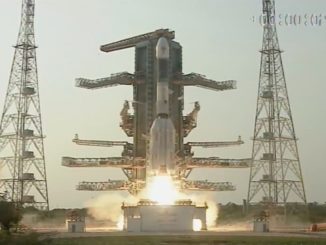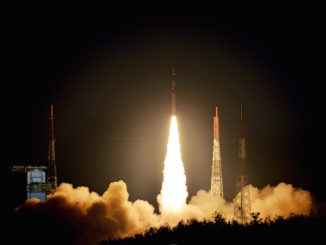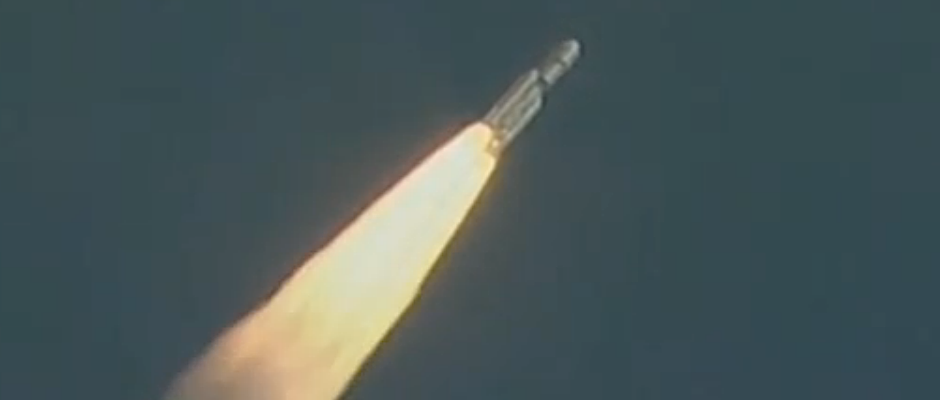
India’s aspiration to launch all of its own satellites — and eventually astronauts — into space got a boost Thursday with a successful test flight of a powerful new rocket and a prototype landing capsule designed for the country’s human spaceflight program.
The 142-foot-tall launcher — designed with all-new rocket boosters and a bulked-up liquid-fueled core stage — took off from a space base on India’s east coast at 0400 GMT Thursday (11 p.m. EST Wednesday).
Spitting out brilliant golden flames from two solid rocket boosters, the launcher climbed through mostly sunny skies over the Satish Dhawan Space Center, an island spaceport located about 50 miles north of the Indian city of Chennai.
Indian officials call the rocket the Geostationary Launch Vehicle Mk. 3, and engineers started work on the $400 million project more than a decade ago.
The objective of Thursday’s test flight, which launched at 9:30 a.m. local time in India, was to demonstrate the performance of the rocket’s liquid-fueled L110 first stage and solid-fueled S200 boosters.
The boosters fired as the countdown clock reached zero, pushing the 695-ton (630-metric ton) rocket off the launch pad, past the speed of sound in less than a minute, and into the stratosphere before two hydrazine-fueled Vikas first stage engines ignited as the GSLV MK. 3 flew about 27 miles over the Bay of Bengal.
The strap-on boosters mounted on each side of the rocket’s core stage jettisoned as planned, officials said, followed by separation of the GSLV Mk. 3’s payload shroud. The L110 main stage switched off its Vikas engines just after the five-minute point in the flight.
Engineers and dignitaries gathered in the launch control center broke into applause as an official announced the progress of the mission.
The last stage of the mission began moments after cutoff of the rocket engines, when the first stage fell away from the GSLV Mk. 3’s second stage, which flew in an inert, inactive mode on Thursday’s launch.
Without a push from the third stage, the rocket did not reach the velocity required to enter orbit around Earth. It was supposed to top out at a speed of nearly 12,000 mph (5.3 kilometers per second) and attain a maximum altitude of 78 miles (126 kilometers), according to the Indian Space Research Organization.
Officials said the rocket hit its marks.
“This was a very significant day in the history of the Indian space program,” said K. Radhakrishnan, chairman of ISRO. “For the advanced launch vehicle that can carry a four-ton class of communications satellite into orbit, India started the development process a decade ago, and just now we completed the first experimental flight of the GSLV Mk. 3 vehicle.”
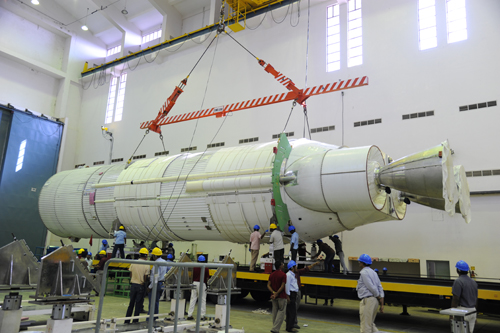
The launcher’s solid rocket boosters and first stage engines worked as expected, Radhakrishnan said in remarks after the mission’s completion.
“India, you have a new launch vehicle,” said S. Somanath, ISRO’s project director for the GSLV Mk. 3 rocket. “The payload capabilities of our current launch vehicles have been significantly enhanced through the development of this launch vehicle.”
The rocket’s passenger Thursday was a gumdrop-shaped capsule ISRO says is a testbed for a spaceship India is designing to carry astronauts into orbit.
The capsule’s demo flight — dubbed the Crew Module Atmospheric Re-entry Experiment, or CARE — was aimed at checking the workings of the craft’s heat shield made of ablative material and carbon phenolic tiles. The heat shield was expected to encounter temperatures of near 2,000 degrees Fahrenheit during descent.
One manager described Thursday’s flight — with dual test objectives for the GSLV Mk. 3 rocket and crew module — as “an experiment in an experiment.”
“We had another experimental module in this mission,” Radhakrishnan said. “That is the unmanned crew module test to understand the re-entry characteristics. That also has worked extremely well. The crew module has splashed down as expected in the Bay of Bengal.”
The module was supposed to align itself for re-entry with on-board rocket thrusters, plunge back into the atmosphere at an altitude of around 50 miles, then deploy parachutes in three stages to slow its fall for splashdown about 1,000 miles downrange from the GSLV Mk. 3’s launch base.
Recovery forces from the Indian Coast Guard were sailing toward the splashdown zone, which was located nearly 400 miles from Port Blair in the Andaman Islands.
An ISRO official said the last data received from the capsule indicated it had deployed its 100-foot-diameter main parachutes. A radio beacon on the landing craft was expected to broadcast its location to recovery vessels.
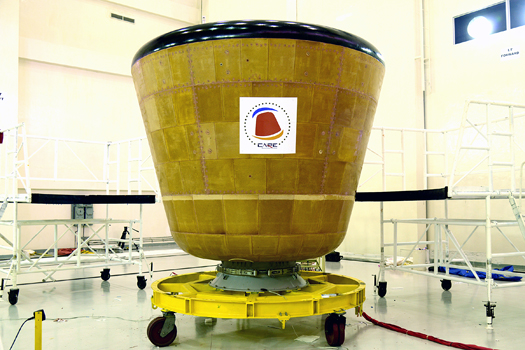
Standing nearly 9 feet tall with a diameter of about 10 feet, the capsule is the same size and shape of the spacecraft Indian engineers plan to develop for piloted missions. The capsule weighs more than 8,200 pounds, or about 3.7 metric tons.
Indian engineers from Hindustan Aeronautics Ltd. fabricated the car-sized module, and ISRO added sensors, strain gauges, a guidance and control system and a heat shield for the suborbital flight.
India’s human spaceflight program has been subject to multiple starts and stops in recent years, and ISRO says it would take seven years and about $2 billion to complete the crew capsule project.
The Indian government has not approved the plan, but New Delhi granted about $22 million for ISRO to work on technologies needed for a piloted space mission, according to the Hindu, an English-language newspaper in India.
If India proceeds with the crew capsule, it could be ready to fly with astronauts in the 2020s. Officials foresee launching the astronaut crews into orbit on the GSLV Mk. 3 rocket.
But the GSLV Mk. 3 program’s short-term objective is to complete development of a hydrogen-fueled upper stage in time for another demonstration launch in two years.
“With … this experimental flight, we’ll have greater confidence to put a flight-worthy cryogenic stage on this rocket and have the first developmental flight in another two years,” Somanath said.
Once the rocket is operational, the GSLV Mk. 3 will fly at least two times a year to haul India’s heaviest communications satellites into orbit, ending the country’s reliance on foreign launch providers.
The rocket can deliver up to four metric tons — about 8,800 pounds — into a high-altitude geostationary transfer orbit. That is nearly double the capacity provided by the GSLV Mk. 2 rocket currently in service.
The GSLV Mk. 3 can lift 10 metric tons, or around 22,000 pounds, into an orbit a few hundred miles above Earth. It can also dispatch bigger scientific probes to the moon, Mars and other destinations.
“This is the largest launch vehicle development program that ISRO has ever undertaken,” Radhakrishnan said.
Each of the GSLV Mk. 3’s boosters is made of three segments pre-packed with 200 metric tons of solid fuel, oxidizer and binding agent.
“It’s one of the heaviest launch vehicles ever developed, weighing 630 tonnes,” Somanath said. “The technological criticality in developing this vehicle is in putting two big boosters of the S200-class as strap-ons, which puts very tight requirements on controlling its differential thrust.”
Follow Stephen Clark on Twitter: @StephenClark1.


